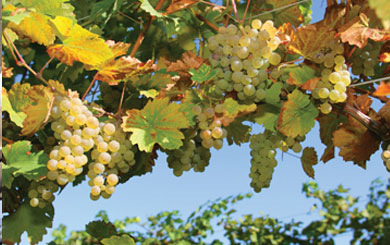 Michigan grapes are not just for juice and jam anymore!
Michigan grapes are not just for juice and jam anymore!
There’s never been a better time to grow grapes in Michigan, even in the chilly U.P. Thanks to U.S. and European breeders, there are many options for growing a delicious variety of grapes for fresh fruit, juice or wine-making.
Grapes are a big deal along our Lake Michigan coast, and increasingly in all corners of the state. Most of the 15,000 acres grown here are for juice, jams and jelly. However, wine grape production has literally exploded over the last 10 years, says Duke Elsner, small fruit specialist at MSU Extension.
“Michigan now has over 100 wineries, compared to about 10 years ago, when there was 25,” Elsner says. “We’re not just a casual producer of wine anymore.”
The wine quality is “fantastic,” he adds, owing in part to the many grape varieties now available to growers. Varieties coming from the University of Minnesota are especially notable, he says, including Frontenac, which is hardy for wine-making. Riesling is currently the most-planted variety here, and pinot and chardonnay are also used.
Buying & Planting Grapes
When buying grape plants, avoid those in cardboard boxes sitting for who-knows-how-long on a discount store shelf. These could easily be stressed from the heat and drying-out occurring in some stores.
Your grapes should be planted in full sun, on level or sloping ground. (The ideal location is east of a large body of water, but of course not all of us have this option.) Fortunately, there are many hardy varieties like the juice and jelly “Beta” grapes that have been growing on my property for several years.
Grapes are also adaptable to different soil types, he says, but generally do best in loose, sandy loam. Amend clay or sandy soils with organic matter, and a soil test can reveal what’s needed to bring the pH in balance and beef up the nutrients. Visit MSU Extension online at msue.msu.edu/ or call 517-355-2308 for more details on soil testing.
Grapes are normally planted from year-old vines, in front of a sturdy trellis or fence. I use the Four Arm Kniffen System to trellis grapes, but there are others, including the Hudson River Umbrella system.
To build a trellis, sink cedar posts, treated 4x4s, or metal stakes at least 2 feet into the ground. Space the posts 6 to 8 feet apart for a single planting. Use a #9 wire for the top wire, and #12 for the bottom. Fasten the bottom wire 30 inches from the ground, and the top one 30 inches from the bottom wire. Fasten the wire in a way that allows you to tighten it later.
Each vine will need to be trained up the trellis vertically the first year. By year two, there will be “arms” that must be trained along the wire. Select four of the thickest arms to train along the wires (two per wire; a total of four arms). Each arm should have eight to 10 buds, and will be about 2 feet long. Select four more canes as close to the arms as possible and cut them back to about 6 inches, leaving only two buds. These are called renewal canes and will produce fruit the following year. Remember this setup, as you will need to repeat it each year when you prune in late winter or early spring. Pruning this way may seem drastic, but it’s necessary to ensure a healthy harvest.
Protect and Fertilize
To keep the grapes producing to their potential, fertilize each spring with a 10-10-10 or organic fertilizer, and mulch around the base of the canes to control weeds. Shallow cultivation (no more than 2 inches) is recommended.
Elsner, who is an entomologist by training, says grapes can go a number of years without disease and insect problems, especially if not planted close to wild grapes. He suggests buying hybrid varieties with stated disease resistance, and watching for pests like the dreaded Japanese beetle and rose chafer.
The biggest threat to grapes appears to be song birds, Elsner adds. Netting may be needed to keep them from eating your grapes. If deer are a problem in your area, especially during the establishment phase, protective mesh or a cage may also be needed.
Grapes won’t take up much of your time, with the exception of the annual pruning and watching for critters. They’re also pretty easy to propagate from stem cuttings, and will produce much sooner than most fruit trees (two years vs. four or five). Finally, you won’t need a ladder to pick and enjoy them.
Neil Moran gardens in the U.P. and writes about it at northcountrygardening.blogspot.com.





